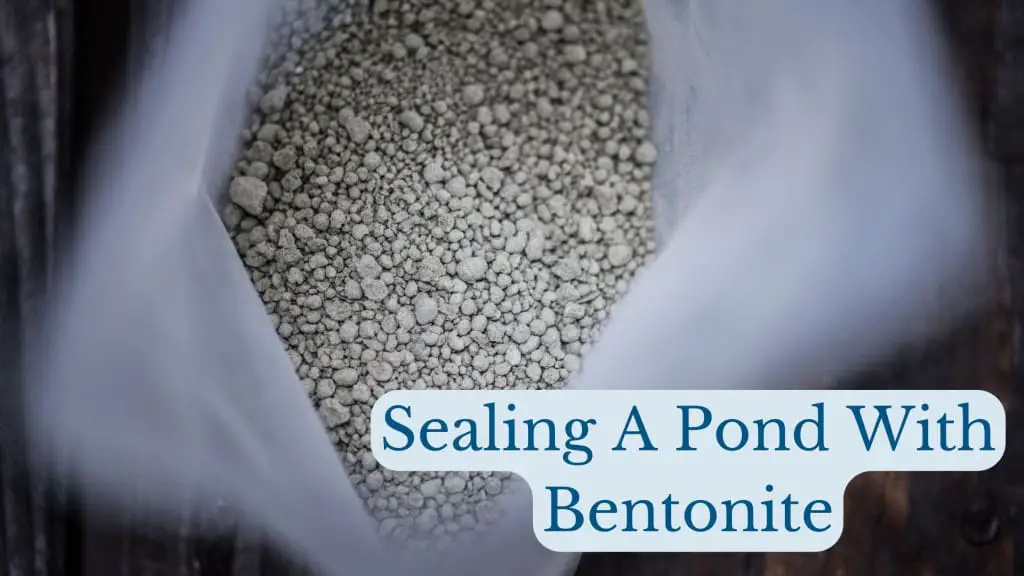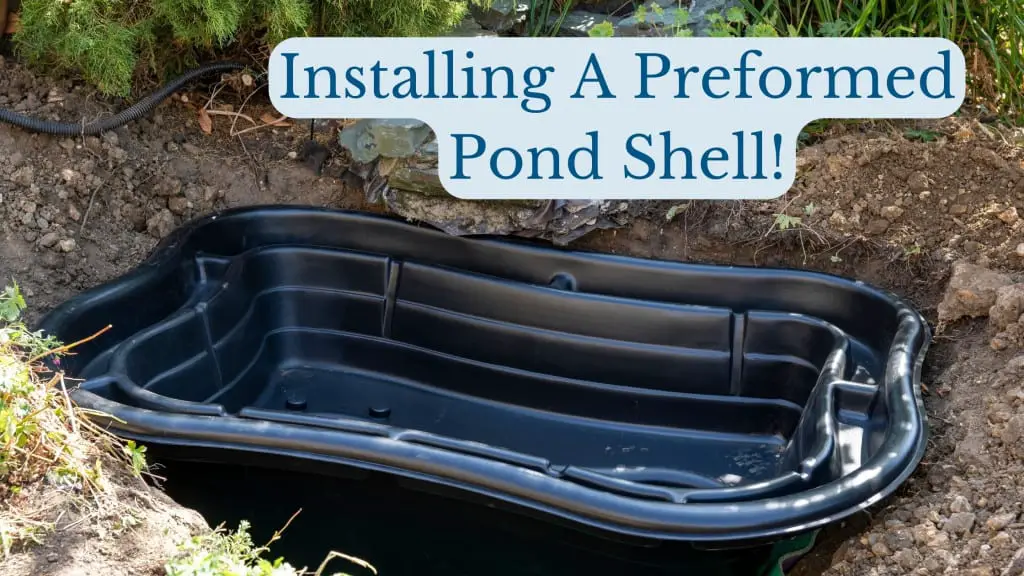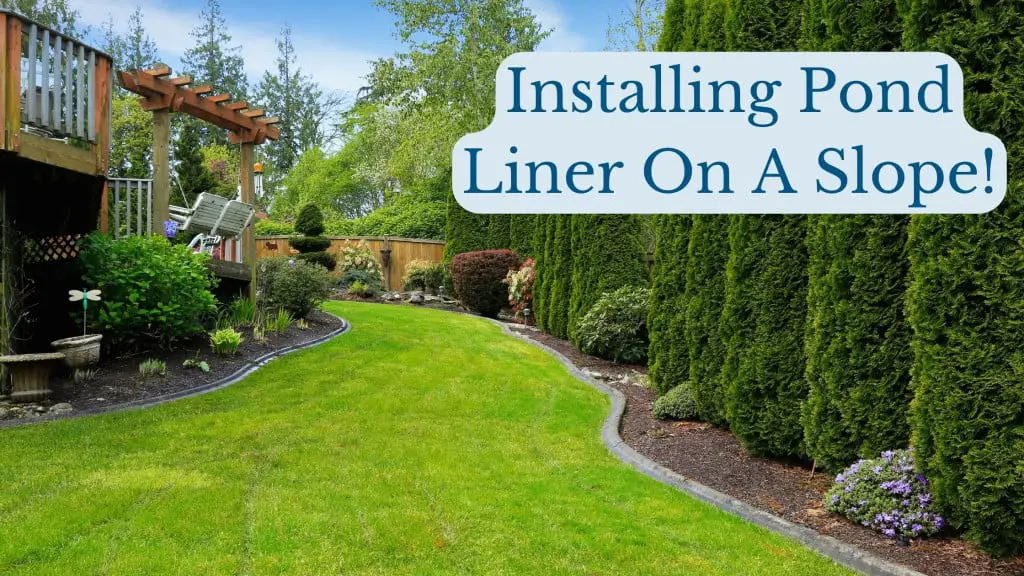Ready to dive into the world of pond creation? Our beginner’s guide below is brimming with easy-to-follow steps and info just for you! Feel free to hop around using the table of contents to find the info that splashes out at you. Interested in checking out our latest pond tips and articles? Check them out here:
Okay, now on with our pond guide!
Table of Contents
Thinking about spicing up your backyard with a splash of serenity? Imagine stepping out to the gentle sounds of water rippling in your very own pond, a tranquil retreat where nature comes to play right in your garden. Building a small pond can transform your outdoor space into a vibrant ecosystem, teeming with life and adding an air of calm to your daily hustle.

Installing a pond might seem daunting, but it’s more like an adventure you embark on — one that rewards you with a living piece of art. Your mission should you choose to accept it, involves playing with elements like the soothing solar-powered pumps that promise a healthy pond without the extra cost on your electric bill. Picture it: no wires, just the sun and water dancing together. And the pond liner, oh! It’s the unsung hero, keeping everything contained. The 45-mil-thick EPDM rubber pond liners are the favorites, giving you a robust barrier against leaks and the wiles of wayward tree roots.
But here’s the secret, the beauty of your pond isn’t just for show; it’s a helping hand for your garden too. A well-placed pond attracts pollinators, wards off pests, and becomes a hub for local wildlife. A little world of its own, your pond serves as a natural reservoir, making every drop of water count, especially when you’re dabbling in organic gardening. So, are you ready to dip your toes into the world of ponds? Strap on your boots; it’s time to make a splash in your backyard!
Planning Your Pond

Embarking on building a pond can inject a slice of serenity into your backyard. Let’s ensure you’re equipped with the right knowledge to create that tranquil garden oasis!
Choosing the Right Location
Choosing the right location in your garden is crucial. You’ll want ample sunlight, but not so much that algae overrun your pond. Find a spot with partial shade—perhaps near a tree or shrubbery that doesn’t shed excessively. Remember, you want your pond to enhance your garden’s visual harmony, not disrupt it. Also, keep an eye out for runoff from rain that could introduce chemicals or debris into your peaceful pond.
Determining Size and Depth
Next up, let’s talk about the size and depth. The size of your backyard will influence this, but a good rule of thumb for a small pond is about 2 feet deep. This discourages predators and promotes a healthy ecosystem. Contemplating a large pond? You may go as deep as 18 to 24 inches for koi or even deeper to counteract winter freeze. How do you mark it out? Take a garden hose, it’s perfect for outlining the shape on the ground before you start digging.
Selecting Pond Materials
When it comes to materials, quality is key. A rubber liner like EPDM is highly recommended due to its durability and flexibility. Butyl pond liners are another robust option. For the pond’s edge, you can use stones or gravel which blend naturally with your garden and help anchor the liner. Make sure to have a reliable pond pump and proper filtration to maintain water clarity and quality.
Designing for Aesthetic Appeal
Finally, let’s get creative with your pond’s design! Infuse your personal style – whether it’s a whimsical wonderland with timber bridges or a minimalist pool reflecting the sky. Incorporate different rocks and features to create visual interest and support wildlife that might visit for a drink. Choose plants that will thrive in your specific conditions and accentuate your pond’s beauty, proving that aesthetic appeal and functionality can go hand-in-hand in landscaping.
Remember, your pond is not just a water feature; it’s a living, breathing ecosystem that you’re crafting. Take your time in planning, and you’re sure to build a pond that brings your garden to life.
Installation Techniques

Ready to transform your backyard with the soothing charm of water features? Whether you’re looking to invite a symphony of wildlife or just enjoy a peaceful water display, getting the installation techniques right is crucial for your very own pond. Let’s dive right in and get those hands dirty!
Excavating the Pond
Ever played in the dirt as a kid? Here’s your adult excuse to do it again – but this time, it’s called landscaping. Begin by clearly marking the pond’s outline. Grab your shovel and start excavating, keeping about 18 inches deep for smaller ponds and deeper for larger ones. Check with a spirit level regularly to avoid a wonky waterscape. Remember to slope the sides gently; this isn’t the Grand Canyon!
Laying the Liner
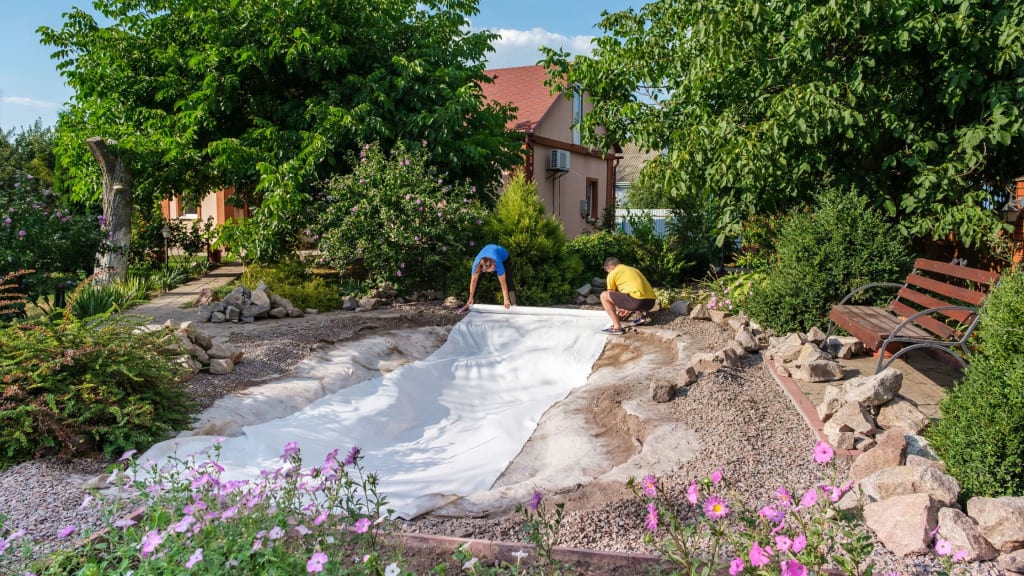
Think of the liner as the pond’s skin – it’s gotta be tough! After clearing the soil of sharp stones, roll out the underlayment to cushion the pond liner. Carefully lay your chosen liner over it, making sure it fits snugly into every nook. It’s like tucking in a blanket, but no bedtime stories here. Secure the edges with heavy stones, and voilà, you’re waterproof!
Adding Water Features
Water standing still is a bore; let’s make it dance! Considering a waterfall or fountain not only looks magical but also ensures vital circulation for pond health. Install your pumps and filters, and position that waterfall just right to get the best “whoosh”. The sound of running water? Music to outdoor ears.
Creating a Wildlife-Friendly Environment
Want to be the best new spot in town for birds, hedgehogs, frogs, and even dragonflies? Keep things natural with vegetation and rocky hideouts to provide sanctuary for your amphibian amigos and winged wonders. Not only do they add beauty, but they also maintain an ecological balance. It’s like hosting your own nature reserve!
By following these techniques, you’ll ensure a sturdy and beautiful pond, teeming with life and ready to be the tranquil cornerstone of your outdoor space. Happy pond building!
Pond Equipment
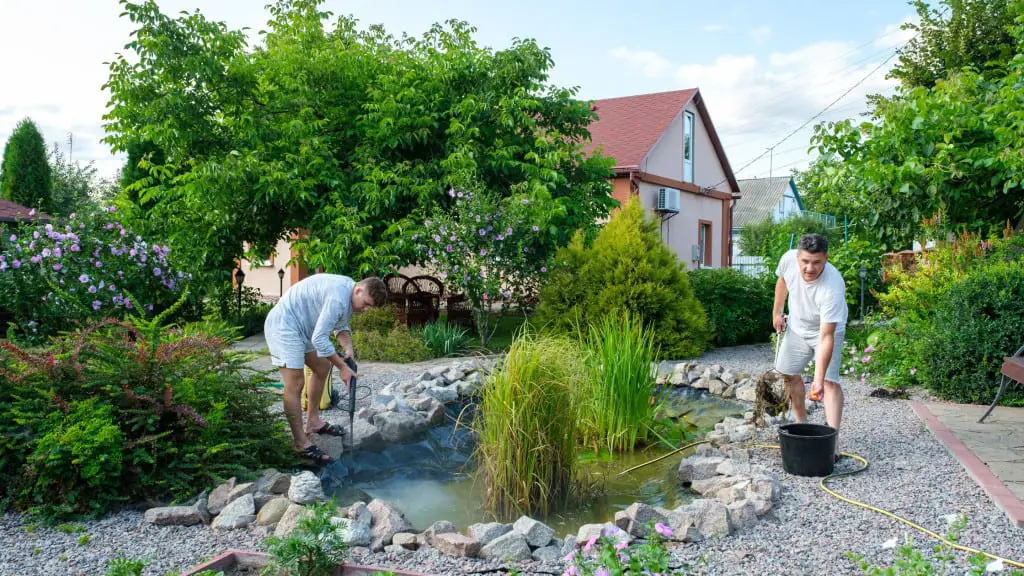
Before diving into the world of pond equipment, remember that the right selection is crucial for ensuring water quality and ease of maintenance. Let’s get you set up with the essentials.
Selecting a Pump and Filter
Have you ever considered what keeps that sparkling pond water moving? It’s all in the pump and filter combo! Here’s how you pick the right ones:
- Pump: Your pump needs to match the size of your pond for effective circulation—a key to clear water. Look for a pump that circulates your pond’s total volume at least once every two hours.
- Filter: You’ll find two types – mechanical and biological. Mechanical filters catch debris, while biological filters promote good bacteria growth that breaks down waste, improving water quality.
Selecting the right pump and filter isn’t just about keeping your pond water clean; it’s about ensuring a healthy ecosystem for your underwater friends!
Choosing the Right Hose and Tubing
Got a pump? Great! But it’s not going to do much good without the hose and tubing to transport your water. Here’s your quick guide:
- Hose: Use a garden hose to fill your pond, but for connections between pumps and filters, spring for tubing that’s sturdy and kink-resistant.
- Tubing: The tubing diameter should fit your pump’s output to avoid any bottlenecks in water flow. Strong, durable tubing ensures efficient water movement and helps maintain your system with less fuss.
Choosing the correct hose and tubing can be a real game-changer for your pond’s health and your sanity as it reduces the need for frequent maintenance!
Pond Ecology and Maintenance
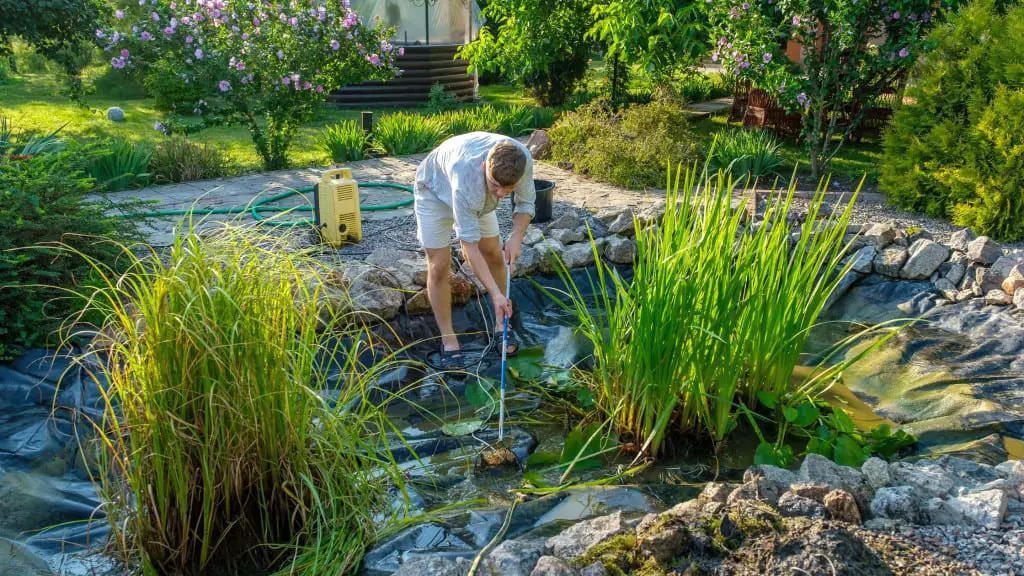
Creating a thriving pond ecosystem isn’t just about filling a hole with water and letting nature take its course. You’ve got to nurture it! This means understanding how various elements interact, ensuring your fish are happy, and keeping the water so clear you could almost read a book through it. Let’s dive into the key components of pond ecology and how to maintain your aquatic paradise’s health all year round.
Understanding the Nitrogen Cycle
Have you wondered why your pond water is sometimes clear and sometimes, well, not so much? The nitrogen cycle is your answer. Here’s the deal:
- Fish waste and decaying plants release ammonia into the water.
- Beneficial bacteria in your pond’s filter convert ammonia to nitrites, which are still harmful.
- More helpful bacteria transform nitrites into nitrates, which aquatic plants use to grow.
Maintain a robust filter system and consider adding a biological enhancer to boost beneficial bacteria, especially in new ponds where the cycle isn’t fully established. Consistently high-quality water depends on a well-functioning nitrogen cycle.
Managing Algae and Water Clarity
Algae – the green stuff that can make your pond look more like pea soup than a backyard oasis. But don’t fret! Here’s how you keep algae under control:
- Aquatic plants: They compete with algae for nutrients. Populate your pond with a mix of floating and submerged plants.
- Regular cleaning: Skim off debris and clean filters to prevent nutrient buildup.
- Algaecides: They can help, but use them wisely – overdoing it can harm your fish.
To maintain the sparkle, regularly test your water to keep its quality in check. Balance is key; too many nutrients or an overstock of fish can tip the scales in favor of algae.
Regular Care and Winterizing Your Pond
Like any pet, your pond needs regular care, and that care shifts as the seasons change. Here’s your to-do list:
- Spring: Clean out any debris and kickstart your filtration system.
- Summer: Top-off water levels, feed your fish, and keep plants trimmed.
- Autumn: Ready your pond for chillier temperatures with a deep clean.
- Winter: Protect your pond from freezing with a de-icer, and consider a pond aerator to keep oxygen levels up.
Don’t forget! Before adding tap water, treat it to remove chlorine that can harm your fishy friends.
And there you have it, your pocket guide to pond ecology and maintenance. Stick to these tips, and your pond will be in tip-top shape, setting the stage for countless peaceful afternoons enjoying your own slice of nature.
Aquatic Life
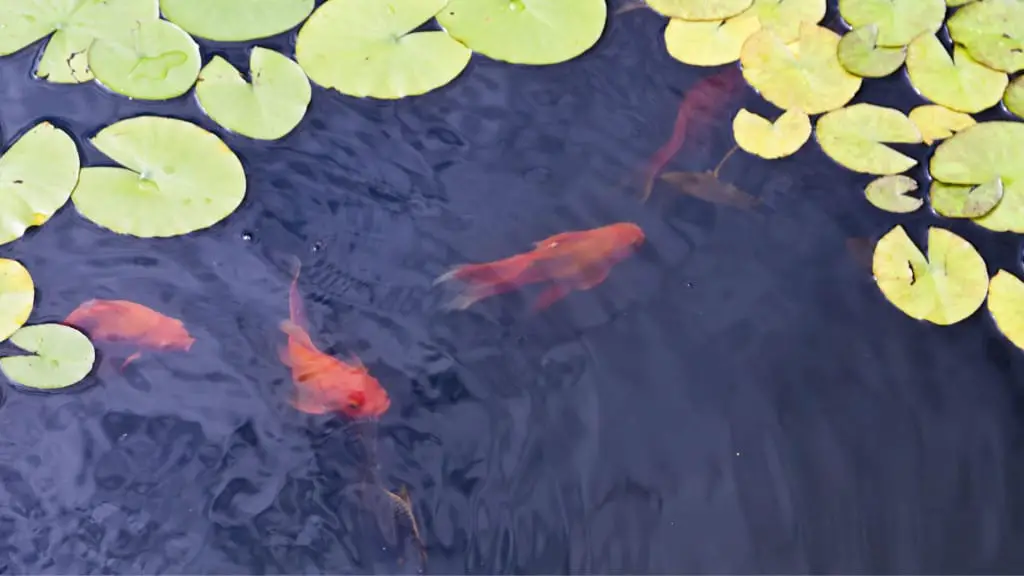
So, you’ve got your pond, and you’re ready to bring it to life, right? The aquatic life you choose is the heartbeat of your backyard oasis, creating a vibrant ecosystem. Let’s dive into what makes your water world thrive!
Stocking Your Pond with Fish
Are you pondering what fish to stock? Goldfish are a go-to for beginners, but it’s key to consider size and compatibility. For a small pond (10-50 gallons), stick to tinier types like rosy red minnows or mosquito fish. Remember, space is a luxury underwater!
- Goldfish: Avoid in small ponds
- Rosy Red Minnows: Suitable for small waters
- Mosquito Fish: Great for mosquito control
Plants for a Healthy Ecosystem
Plants are not just decoration—they’re crucial for a balanced ecosystem. Submerge yourself in the world of aquatic plants like hornwort to oxygenate the water or shoreline lovers like water forget-me-not and brooklime. They’re nature’s way of keeping your pond healthy and your fish happy.
- Hornwort: Oxygenating powerhouse
- Water Forget-Me-Not: Charming and useful
- Brooklime: A marginal must-have
Creating Hiding Areas for Fish and Wildlife
Fish and local wildlife love a good game of hide and seek. Use rocks, logs, and foliage to create hiding areas. It’s not only functional but also boosts the aesthetic appeal! Plus, these natural nooks are vital for protection and breeding. Peek-a-boo, I see you!
- Rocks: Sturdy and stylish
- Logs: Natural and functional
- Foliage: Perfect for a hideaway
Troubleshooting and Repairs

Taking care of your pond can be quite the adventure, can’t it? Whether it’s a sudden leak that turns your backyard into an unintended water feature, or algae taking over like an unwanted guest, we’ve got you covered. Let’s dive into making sure your pond stays in tip-top shape.
Addressing Common Pond Problems
Leaky Liner: Spotting a water loss? Don’t fret! A leak might just be the culprit. To fix a minor leak, you can use a pond sealer available at most pond supply stores. For those pesky, hard-to-find leaks, filling the pond with water and monitoring the water level can help you determine the area in need of repair.
Algae Overgrowth: Overrun with algae? Implement a one-two punch strategy. First, a good pond filter helps cut down the nutrients that feed your green nemesis. Next, consider using a pond blanket to shade the water and reduce photosynthesis.
Oxygen Levels: Gasping fish? It’s time to boost your pond’s oxygen. A simple aeration system can significantly increase oxygen levels, making for happier, healthier fish.
Maintaining Your Pond Equipment
- Pump Care: Forever the pond’s heart—keep your pump running smoothly with regular cleaning. Check on the intake and remove debris to prevent clogs and maintain flow.
- Filter Cleaning: Like the pump, your filter needs love too. Clean or replace the media as instructed. Trust me, your pond buddies will thank you.
- Regular Inspection: Just like checking your car’s oil, make sure to inspect all equipment regularly for any signs of wear or damage. It’s much easier to replace a part than to overhaul your entire pond, right?
DIY Fixes and When to Call a Professional
- Pump Issues: If the water’s still and your pump is silent, check the basics—like power supply and blockages. Sometimes a quick clean is all it takes to get it humming again.
- Leak Patches: Small liner tears? Apply a liner patch kit. If applying adhesive feels like crafting a kindergarten art project, you’re doing it right.
Professional Help: If you’re scratching your head and googling every term you come across, it might be best to call in the pros. Major leaks or electrical problems? Get on the phone and let the experts take the wheel.
Juggling pond maintenance with ease is all about knowing when a little DIY can save the day or when it’s time to bring in the pros—because sometimes, even the keenest pond enthusiasts need to leave it to the lifesavers in boots. Keep this guide handy, and you’ll be mastering the art of pond problem-solving in no time!
Enhancing Pond Experience
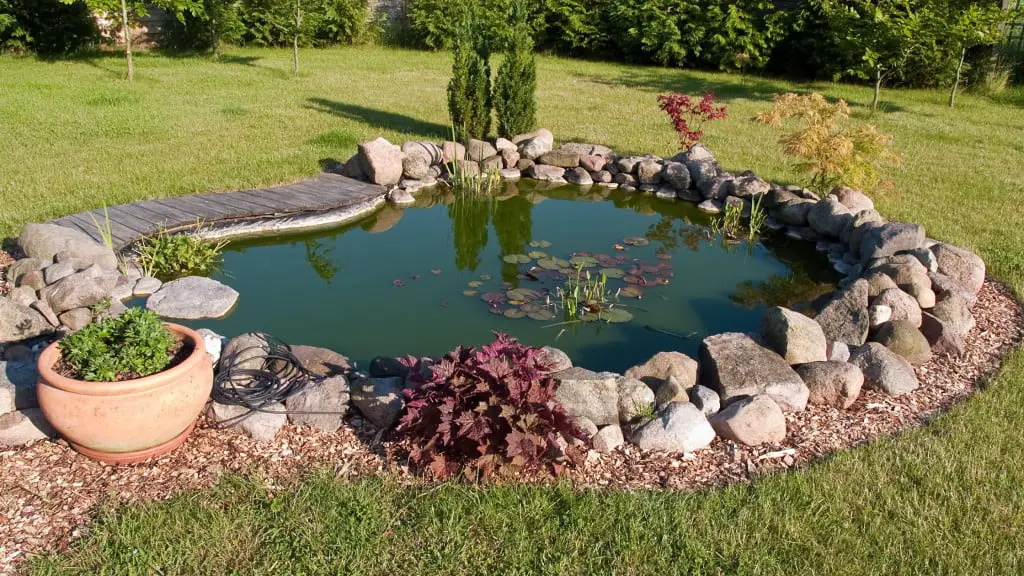
Creating a captivating backyard pond isn’t just about filling a hole with water; it’s about crafting an experience. Here, we’ll cover practical tips to elevate your pond’s allure, ensure safety, and integrate it seamlessly into your landscaping.
Incorporating Seating and Pathways
Have you ever imagined lounging by your pond, immersed in the tranquil sounds of nature? To make this a reality, strategic seating is key. Think about:
- Benches or chairs: Durable, weatherproof options are perfect for relaxing beside the water.
- Pathways: Use stepping stones or gravel paths to guide visitors around the water’s edge, highlighting your pond’s best views.
Lighting and Decorating Your Pond
Lighting isn’t just about visibility; it’s about setting the mood. With the right features, your pond can transform from a day-time sanctuary to a night-time spectacle.
- Underwater lighting: LED lights can give a magical glow to your pond after sunset.
- Floating lights: For a whimsical touch, add solar-powered floating lights that change colors.
- Decor: Don’t forget about decorations like statues or a fountain to enrich the aesthetic appeal.
Safety Considerations for Children and Pets
We all love a beautiful backyard space, but keeping loved ones safe is paramount. When it comes to ponds and wildlife:
- Fencing: Consider a fence with a self-closing gate to keep young children and pets at a safe distance.
- Depth markers: Clearly indicate the depth in various sections of the pond, especially if it’s deep.
- Emergency plan: Have a safety protocol in place in case someone falls in and always supervise children around the pond.
Curious about more things, ponds?
Take a peek at our newest guides below, or dive into our full collection of pond articles!
